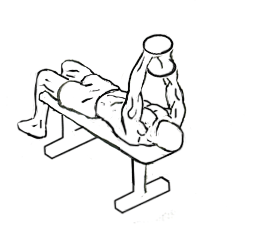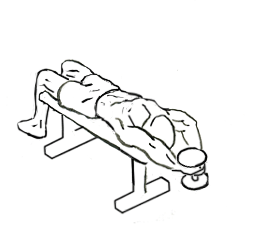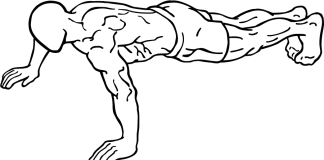Last Updated on September 24, 2014
The Lying Triceps Extension with Dumbbells is a staple exercise for targeting and isolating the triceps. It’s known for its effectiveness in building strength and mass in the back of the arms, making it a popular choice among bodybuilders, fitness enthusiasts, and anyone looking to enhance upper-arm definition. By leveraging gravity, this exercise creates substantial resistance, maximizing muscle engagement and helping to improve arm aesthetics and power.
In this guide, we’ll dive deep into everything you need to know about the Lying Triceps Extension with Dumbbells, from step-by-step execution to common mistakes, variations, and tips to integrate this exercise into your workout routine.
Benefits of the Lying Triceps Extension with Dumbbells
When it comes to strengthening the triceps, this exercise offers several benefits that make it an excellent addition to any workout:
- Isolation of the Triceps: By maintaining a specific angle and range of motion, the exercise focuses on the triceps, minimizing shoulder involvement and allowing you to target the muscle effectively.
- Enhanced Upper-Body Stability: Keeping the arms steady during the exercise requires core and shoulder stability, making it beneficial for overall upper-body strength.
- Increased Muscle Definition: Regularly performing this exercise can improve muscle tone and definition in the arms, especially beneficial for those aiming for an aesthetically balanced physique.
- Improved Elbow Flexion Strength: The movement strengthens the triceps while also enhancing elbow joint mobility and stability, which is useful for other compound exercises such as bench presses and shoulder presses.
Anatomy of the Triceps
To understand why the Lying Triceps Extension with Dumbbells is so effective, it helps to look at the anatomy of the triceps. The triceps brachii, commonly known as the triceps, is a three-headed muscle located at the back of the upper arm. It consists of:
- Long Head: Runs along the back of the arm and connects to the shoulder blade. This head is most activated in exercises where the arms are positioned above the head.
- Lateral Head: Located on the outer side of the arm, it contributes to the “horseshoe” shape and is targeted with heavy pressing exercises.
- Medial Head: Found beneath the long and lateral heads, it assists in elbow extension and provides stability.
The Lying Triceps Extension with Dumbbells primarily engages all three heads, with an emphasis on the long head due to the angle at which the dumbbells are lowered.
Step-by-Step Guide to Performing the Exercise
Step 1: Set Up Your Position
- Lie on a Flat Bench: Position yourself on a flat bench with your head at one end and feet planted firmly on the floor for stability. Ensure your entire back is in contact with the bench.
- Select the Right Weight: Start with a manageable weight, especially if you’re new to the exercise. As you get comfortable, you can gradually increase the load to add resistance.
Step 2: Grip the Dumbbell
- Grasp the Dumbbell with Both Hands: Use an overhand grip with palms facing up. Holding the dumbbell with both hands provides better control and balance throughout the movement.
- Engage Your Core: Tense your core to stabilize your body, preventing any movement from your lower back or torso during the exercise.
Step 3: Position the Dumbbell Over Your Body
- Extend Your Arms Towards the Ceiling: Raise the dumbbell directly above your chest, with arms fully extended but keeping a slight bend at the elbows to avoid locking them.
- Align Your Wrists and Elbows: Ensure that your wrists are aligned with your elbows, preventing the dumbbell from wobbling or causing undue strain on your wrists.
Step 4: Lower the Dumbbell Behind Your Head
- Keep Upper Arms Stationary: While keeping your upper arms and elbows steady, slowly bend your elbows to lower the dumbbell in an arc behind your head. Imagine creating a semi-circle from the ceiling down toward your head.
- Focus on Form: Lower the dumbbell until you feel a stretch in your triceps without compromising shoulder stability. Avoid going too low, as this can strain the shoulder joint.
Step 5: Return to Starting Position
- Engage the Triceps to Lift: Using your triceps, raise the dumbbell back along the same path to the starting position, with arms fully extended.
- Avoid Locking Elbows at the Top: Once you reach the top, maintain a slight bend in the elbows to keep tension on the triceps.
Repeat for the desired number of repetitions, focusing on smooth and controlled movement throughout.
Tips for Perfecting Your Form
Form is crucial in this exercise to ensure effectiveness and prevent injury. Here are some tips to help you perform the Lying Triceps Extension with Dumbbells safely and effectively:
- Control the Descent: Slowly lowering the dumbbell behind your head emphasizes the eccentric phase of the movement, enhancing muscle engagement.
- Keep Elbows Inward: Avoid flaring your elbows outward, as this shifts tension away from the triceps and can lead to shoulder strain.
- Breathing Pattern: Inhale as you lower the dumbbell and exhale as you lift it back up, maintaining steady breathing throughout.
- Focus on the Triceps: Concentrate on using your triceps to raise and lower the dumbbell rather than letting momentum do the work.
Common Mistakes and How to Avoid Them
- Using Too Much Weight: Overloading this exercise can compromise form and increase the risk of injury. Start with lighter weights and focus on perfecting your form.
- Flaring Elbows Outward: This common mistake places stress on the shoulder joint and reduces triceps engagement. Keep elbows pointing toward the ceiling.
- Overextending at the Bottom: Going too low with the dumbbell can place undue stress on the shoulders. Lower only until you feel a stretch in the triceps.
- Rushing the Movement: Performing this exercise too quickly minimizes muscle engagement. Keep a steady pace to maximize muscle tension and avoid using momentum.
Variations to Enhance the Exercise
Once you’ve mastered the basic movement, you can introduce variations to keep your workouts challenging and engage the triceps from different angles:
1. Single-Arm Lying Triceps Extension
Perform the exercise with one dumbbell at a time. This variation increases core engagement and allows you to focus on each arm individually, helping to address any muscle imbalances.
2. Incline Bench Lying Triceps Extension
Set the bench to a slight incline (15-30 degrees). This angle changes the line of resistance, placing more emphasis on the long head of the triceps and adding variety to your triceps training.
3. Lying Triceps Extension with Barbell
Using a barbell instead of dumbbells provides a different grip and can help you lift heavier weights. It’s a good variation for those looking to increase overall strength in the triceps.
4. Lying Triceps Extension with Cable
If your gym has a cable machine, try using a cable for this exercise. The cable’s continuous tension can provide a unique stimulus, making it especially effective for muscle activation throughout the range of motion.
Sample Triceps Workout Routine
Incorporate the Lying Triceps Extension with Dumbbells into a balanced triceps workout routine. Here’s a sample workout plan:
- Warm-Up: 5-10 minutes of light cardio and dynamic stretches.
- Triceps Pushdown (Cable): 3 sets of 10-12 reps
- Overhead Dumbbell Extension: 3 sets of 8-10 reps
- Lying Triceps Extension with Dumbbells: 3 sets of 8-12 reps, focusing on controlled movement
- Dips: 2 sets to failure for a triceps burnout
Safety Tips
Since this exercise involves weight lifted above your head, maintaining safety is key:
- Use a Spotter if Necessary: If you’re lifting heavier weights, consider having a spotter, especially if you’re new to the movement.
- Avoid When Fatigued: As this exercise requires focus and control, avoid it if your arms are already fatigued to reduce the risk of dropping the weight.
- Practice with Light Weights First: Starting light allows you to focus on form, reducing the likelihood of injury.
Progressive Overload Techniques
To continuously challenge your triceps, incorporate progressive overload:
- Increase Weight Gradually: Once you’ve mastered the form, increase the weight in small increments.
- Add Reps: Gradually increase your reps from 8 to 12 for each set.
- Increase Time Under Tension: Add a brief pause at the bottom or top of each rep to increase time under tension, stimulating muscle growth.
Integrating the Exercise into Different Workouts
The Lying Triceps Extension with Dumbbells can be effectively included in various workout routines:
- Push Day: Pair with chest and shoulder exercises to work all the pressing muscles.
- Arm Day: Combine with other triceps and biceps exercises for a balanced arm workout.
- Upper Body Day: Integrate with other compound upper-body exercises, such as bench presses or shoulder presses.
Tracking Your Progress
Track the following metrics to monitor your progress with this exercise:
- Reps and Sets: Note the number of reps and sets completed.
- Weight Used: Document the weight to see steady progress over time.
- Form Adjustments: Jot down any notes on form, such as elbow positioning or shoulder stability, to ensure consistent improvement. Tracking these details helps you focus on areas that need attention and avoid repeating common mistakes.
- Range of Motion: Pay attention to the depth of each rep and how comfortably you can reach a full stretch in your triceps. Over time, as flexibility and strength improve, you may notice a deeper range of motion.
- Tempo: Note the tempo or speed of each repetition. Many people find that varying the tempo—such as slowing down the lowering (eccentric) phase—can increase time under tension and challenge the muscle differently. Tracking tempo helps you stay consistent and gauge progress as you experiment with different styles.
Frequently Asked Questions
1. How much weight should I start with?
- Start with a manageable weight, typically 5-10 kg for beginners, and focus on proper form. Once you’re comfortable with the movement and your form is solid, gradually increase the weight.
2. How often should I include this exercise in my routine?
- For most people, performing the Lying Triceps Extension with Dumbbells once or twice a week as part of an upper-body or dedicated arm workout is sufficient. Avoid overworking the triceps, especially if you’re also doing other pressing exercises like bench presses or shoulder presses.
3. Can I use this exercise to build bigger triceps?
- Absolutely! This exercise is effective for building triceps mass and definition when paired with progressive overload, consistent training, and a balanced diet. Combining it with other triceps-focused exercises will help enhance overall arm size and shape.
4. What should I do if I experience shoulder pain?
- If you feel any pain in the shoulder joint, stop immediately. Shoulder discomfort can be a sign of improper form, weight that’s too heavy, or pre-existing shoulder issues. Reducing weight and focusing on form often helps, but consult a fitness professional or physician if pain persists.
5. Is it better to use a barbell or dumbbells for this exercise?
- Both options are effective, but dumbbells offer more range of motion and allow for better control, reducing strain on the wrists and shoulders. A barbell can be used for heavier lifts and provides a more stable option, though it limits individual arm movement.
Final Thoughts
The Lying Triceps Extension with Dumbbells is an essential exercise for anyone looking to build triceps strength, improve arm aesthetics, or enhance upper-body stability. By focusing on proper form, gradual progression, and controlled movements, you can safely and effectively incorporate this exercise into your routine for long-term gains.
In addition to its strength-building benefits, this exercise emphasizes technique, concentration, and muscle control, all essential for a balanced, well-rounded training regimen. Embrace the challenge, stay consistent, and watch as your triceps develop strength and definition over time!








